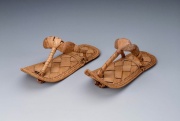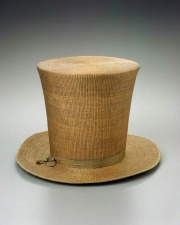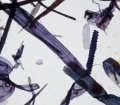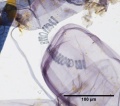Difference between revisions of "Straw"
(username removed) |
|||
| (9 intermediate revisions by 4 users not shown) | |||
| Line 1: | Line 1: | ||
| − | [[File:03.1720-C34494CR-d1.jpg|thumb|]] | + | [[File:03.1720-C34494CR-d1.jpg|thumb|Egyptian sandals<br>MFA# 03.1720]] |
== Description == | == Description == | ||
| − | A general name for stalks from cereal grain plants, such as [ | + | A general name for stalks from cereal grain plants, such as [[wheat]], [[barley]], [[rye]], [[oat]], and [[rice]]. Since ancient times, straw fibers have been woven or braided to form hats, bags, shoes, mats, and baskets. Straw was also used for papermaking in ancient China. It was the primary fiber used for paper in Europe and North America from the 18th century until the 1920s when it was replaced by wood pulp. Straw pulp is still used for strawboard, printing paper, wallpaper, and inexpensive wrapping papers. |
| + | |||
| + | [[File:44.184-SC10775.jpg|thumb|Man's straw hat<br>MFA# 44.184]] | ||
| − | |||
== Synonyms and Related Terms == | == Synonyms and Related Terms == | ||
barley straw; oat straw; rice straw; rye straw; wheat straw; bagasse; espiga (Esp.) | barley straw; oat straw; rice straw; rye straw; wheat straw; bagasse; espiga (Esp.) | ||
| − | == | + | == Physical and Chemical Properties == |
Stains pink with aniline sulfate. Fibers are 1 - 1.5 mm long | Stains pink with aniline sulfate. Fibers are 1 - 1.5 mm long | ||
| + | |||
| + | Paper fiber type: non-woody, grass. Using transmitted light microscopy, pulp is identified by the presence of variable-sized barrel-shaped parenchyma cells. Serrated epidermal cells are abundant. Unwound spiral thickenings are also present. Fibers are short and appear similar to hardwood fibers. It is difficult to distinguish cereal straws from each other (wheat, oat, rye and barely). Appearance with [[Graff "C" stain]]: fibers stain dark, other vessels may have variable colors. Average dimensions of fibers: length 1.4 mm, width 15 μm. Common pulping method: various, typically soda or sulfate. | ||
== Additional Images == | == Additional Images == | ||
| Line 23: | Line 26: | ||
File:37 straw wheat 200X pol.jpg|Straw wheat | File:37 straw wheat 200X pol.jpg|Straw wheat | ||
File:37 straw wheat 200X.jpg|Straw wheat | File:37 straw wheat 200X.jpg|Straw wheat | ||
| + | File:Oat 40x serratedepi.jpg|Oat straw paper pulp | ||
| + | File:Oat 40x unwoundspirals.jpg|Oat straw paper pulp | ||
| + | File:Rice 40x.jpg|Rice straw paper pulp | ||
| + | File:Rice 40x smallvessels.jpg|Rice straw paper pulp | ||
</gallery> | </gallery> | ||
| − | + | == Resources and Citations == | |
| − | == | ||
* G.S.Brady, ''Materials Handbook'', McGraw-Hill Book Co., New York, 1971 Comment: p. 684 | * G.S.Brady, ''Materials Handbook'', McGraw-Hill Book Co., New York, 1971 Comment: p. 684 | ||
Latest revision as of 11:50, 15 October 2020
Description
A general name for stalks from cereal grain plants, such as Wheat, Barley, Rye, Oat, and Rice. Since ancient times, straw fibers have been woven or braided to form hats, bags, shoes, mats, and baskets. Straw was also used for papermaking in ancient China. It was the primary fiber used for paper in Europe and North America from the 18th century until the 1920s when it was replaced by wood pulp. Straw pulp is still used for strawboard, printing paper, wallpaper, and inexpensive wrapping papers.
Synonyms and Related Terms
barley straw; oat straw; rice straw; rye straw; wheat straw; bagasse; espiga (Esp.)
Physical and Chemical Properties
Stains pink with aniline sulfate. Fibers are 1 - 1.5 mm long
Paper fiber type: non-woody, grass. Using transmitted light microscopy, pulp is identified by the presence of variable-sized barrel-shaped parenchyma cells. Serrated epidermal cells are abundant. Unwound spiral thickenings are also present. Fibers are short and appear similar to hardwood fibers. It is difficult to distinguish cereal straws from each other (wheat, oat, rye and barely). Appearance with Graff "C" stain: fibers stain dark, other vessels may have variable colors. Average dimensions of fibers: length 1.4 mm, width 15 μm. Common pulping method: various, typically soda or sulfate.
Additional Images
Resources and Citations
- G.S.Brady, Materials Handbook, McGraw-Hill Book Co., New York, 1971 Comment: p. 684
- Richard S. Lewis, Hawley's Condensed Chemical Dictionary, Van Nostrand Reinhold, New York, 10th ed., 1993
- Hoechst Celanese Corporation, Dictionary of Fiber & Textile Technology (older version called Man-made Fiber and Textile Dictionary, 1965), Hoechst Celanese Corporation, Charlotte NC, 1990
- Matt Roberts, Don Etherington, Bookbinding and the Conservation of Books: a Dictionary of Descriptive Terminology, U.S. Government Printing Office, Washington DC, 1982
- A.Lucas, J.R.Harris, Ancient Egyptian Materials and Industries, Edward Arnold Publishers Ltd., London, 4th edition, 1962












